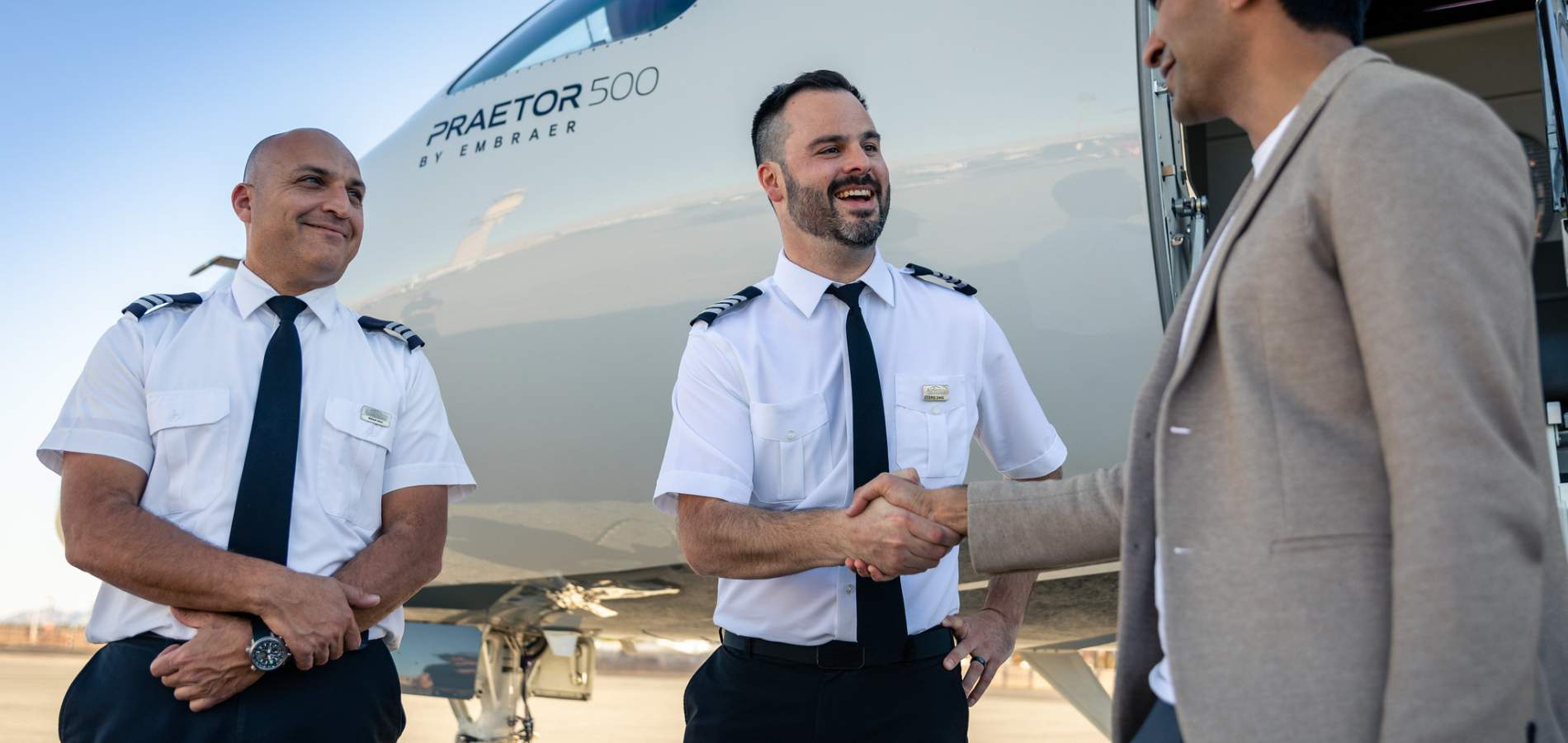Are you thinking about a career as a private jet pilot?
Maybe you’re just beginning to explore the possibilities, or perhaps you’re well into your training and thinking about where you’d like to work after graduation.
Either way, we know you have important questions – questions about career progression and outlook, earning potential, scheduling expectations and quality of life.
We can offer you top pay, work-life balance and the promise that every day will be different. At AirSprint, endless opportunities await you.
Intrigued?
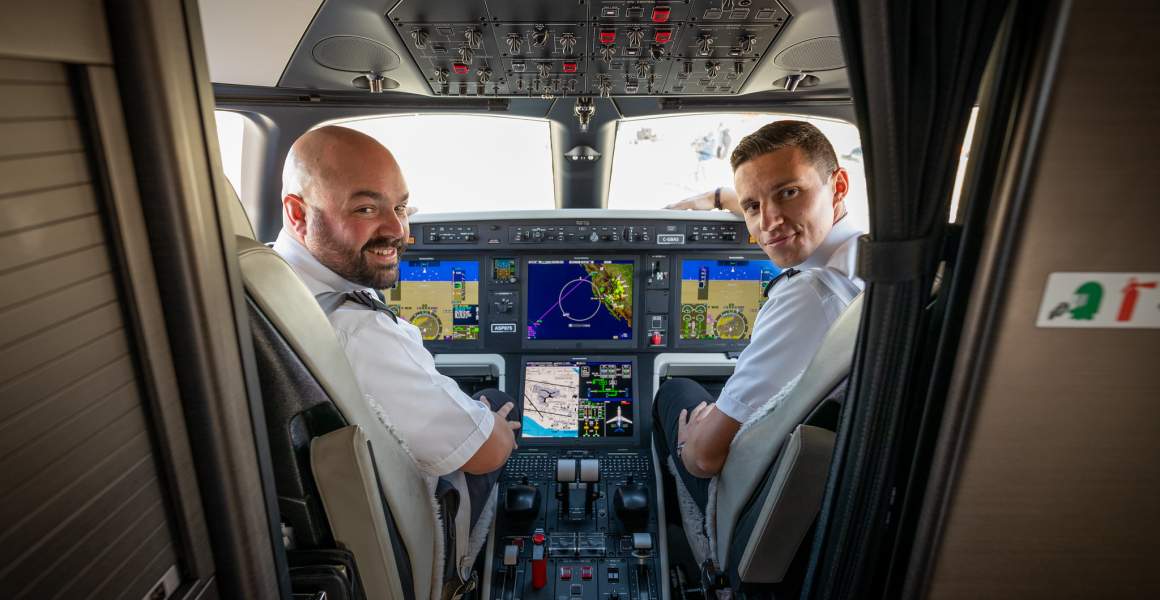
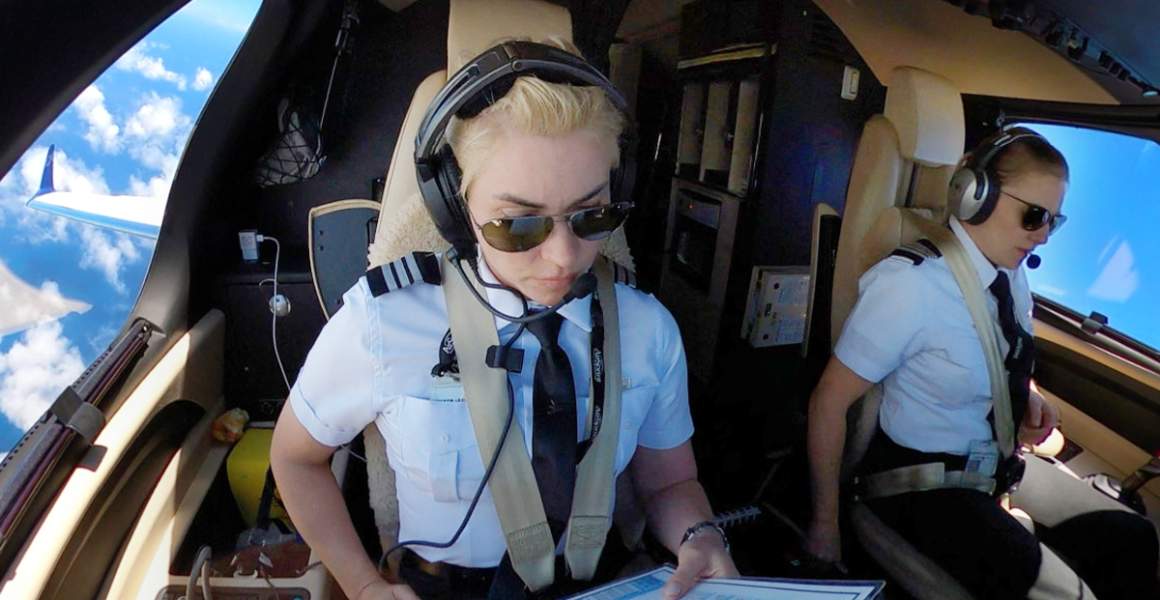
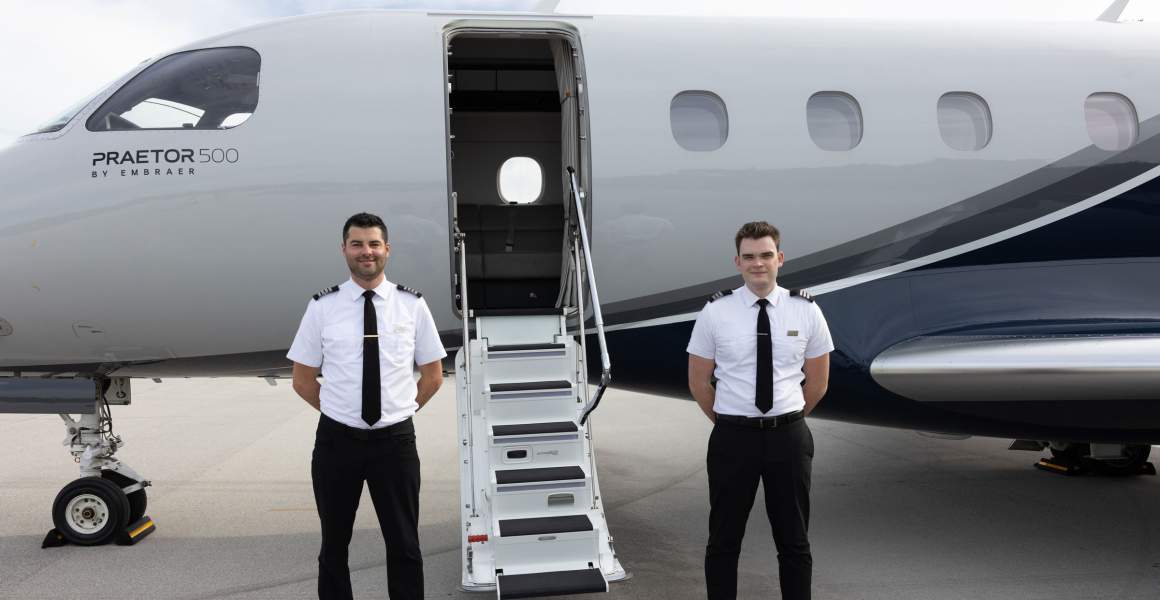
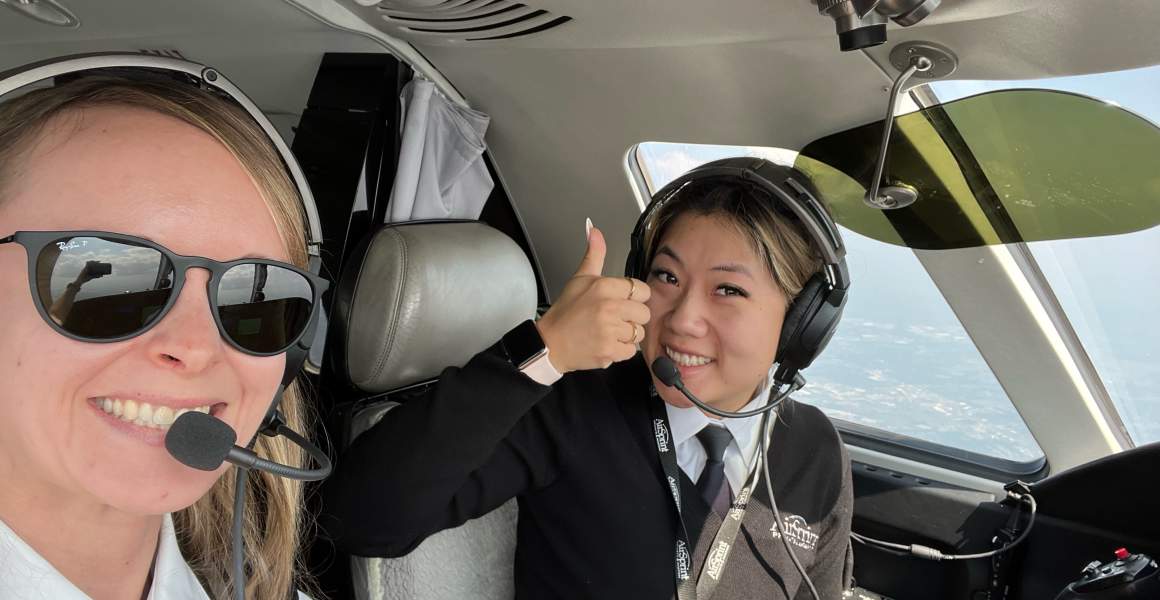
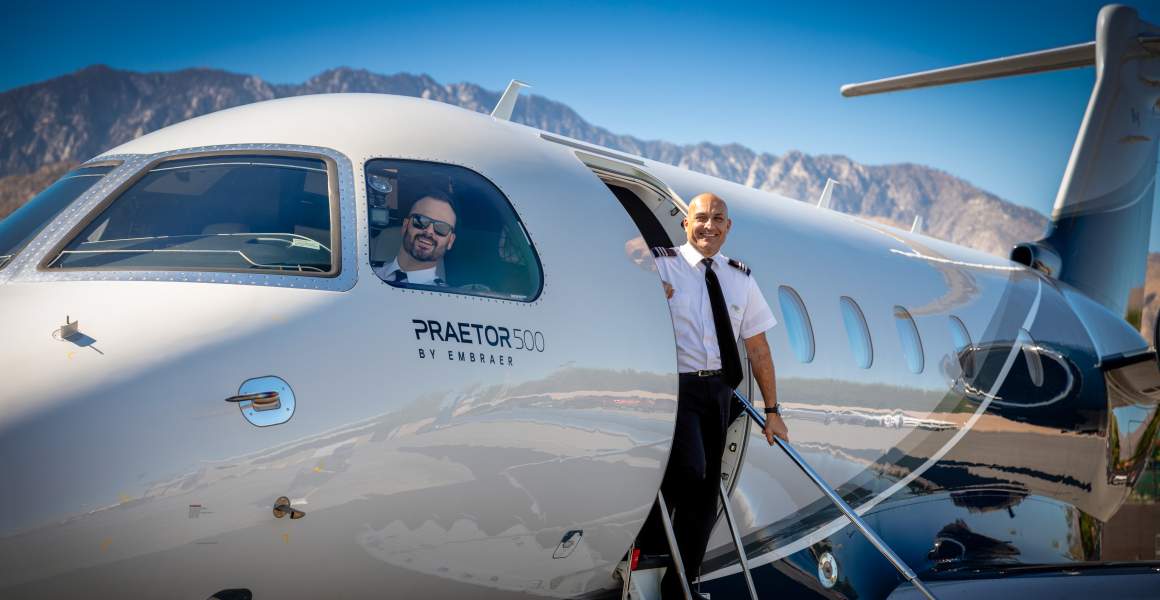
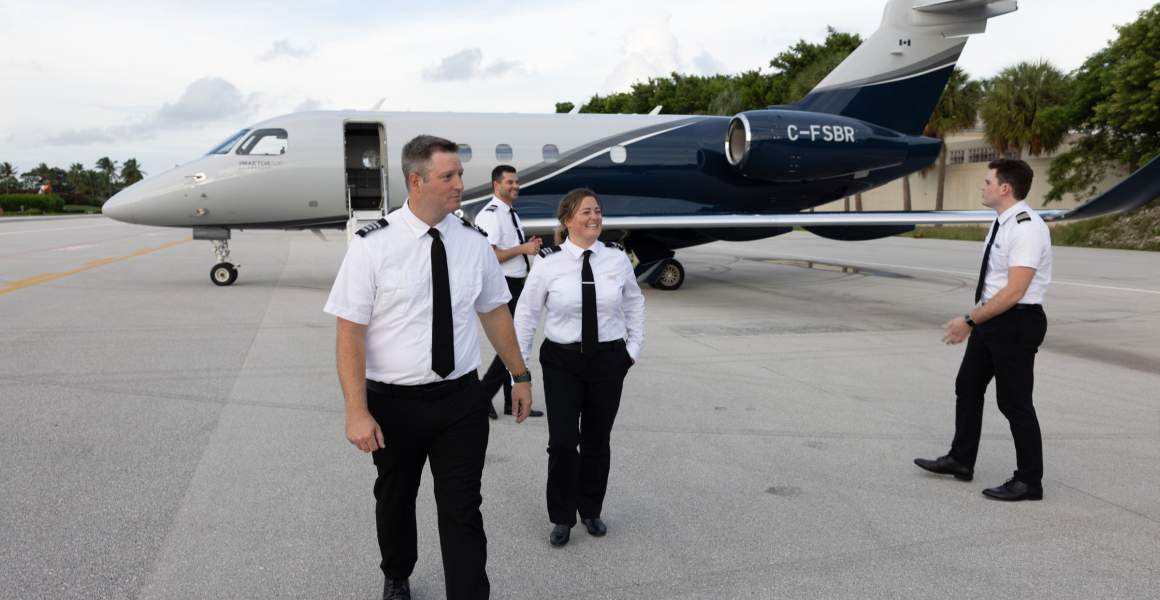
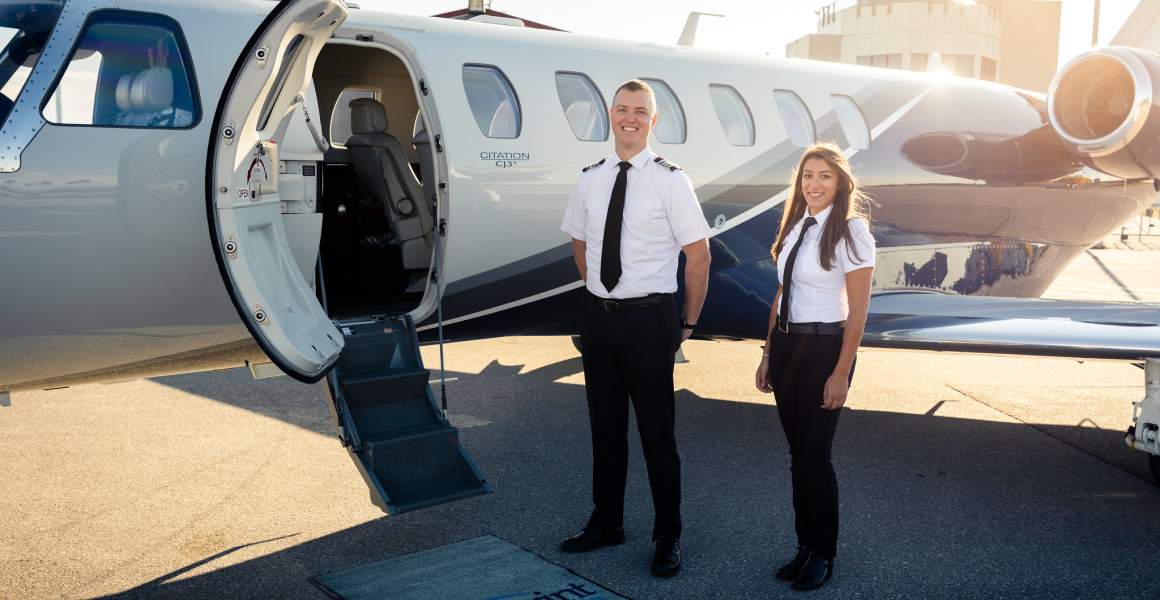
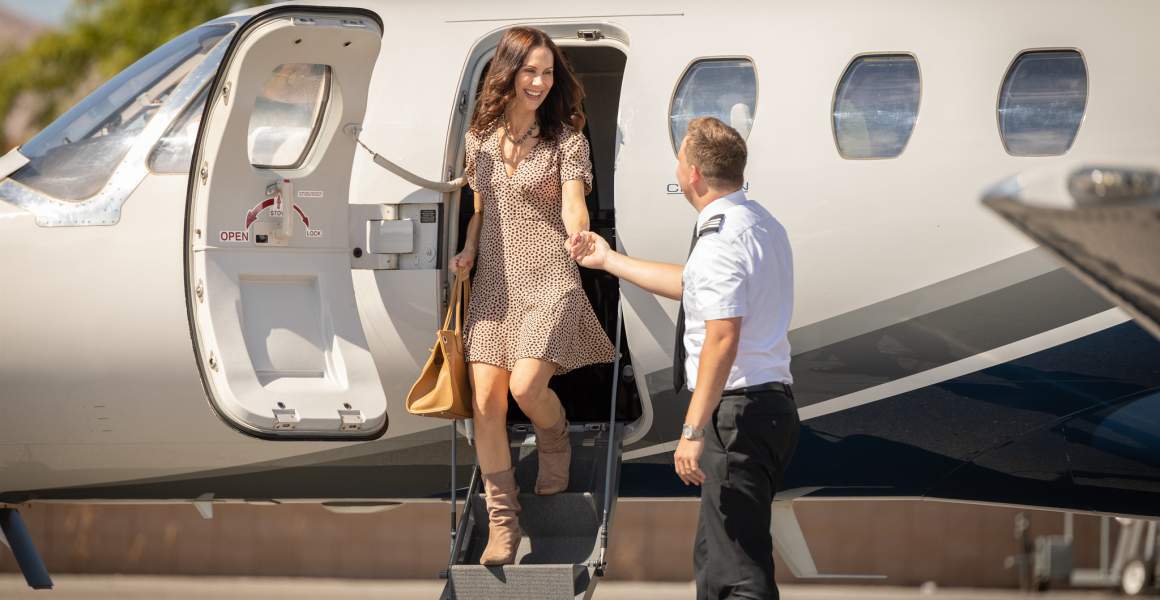
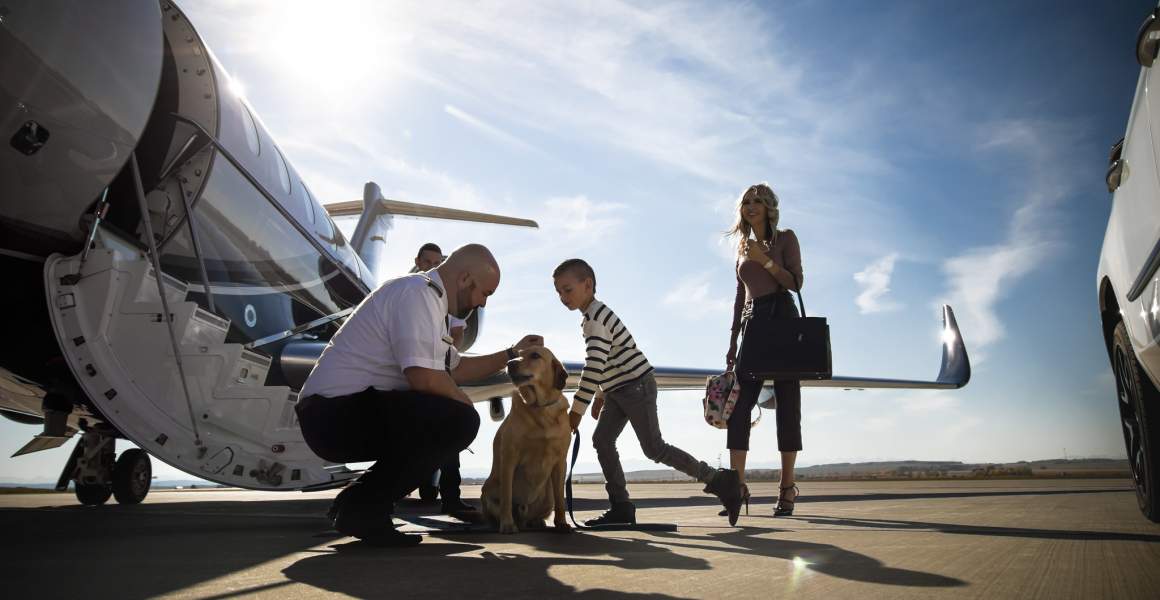
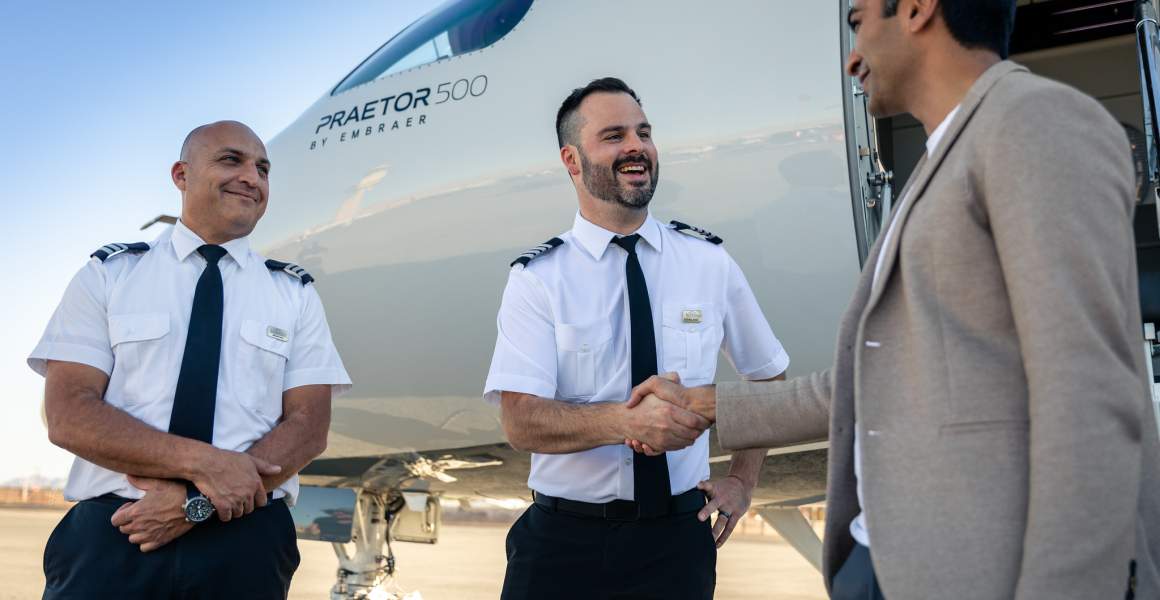
At AirSprint, we’ve been in the business
of delivering bespoke private aviation services since 2000.

As the Canadian authority on Fractional Jet Ownership, we saw tremendous growth between 2019 and 2023, doubling our annual flight hours and growing our fleet from 16 to 33 aircraft!
Today, we are home to more than 175 pilots who have chosen fulfilling careers in the exciting world of private aviation.
Here, AirSprint’s Director of Flight Operations and a new First Officer answer some of your most commonly-asked questions about how to become a corporate pilot – and what to expect when you hit the workforce.
If you still have questions after reading this paper, don’t hesitate to contact the AirSprint team. We’d be happy to speak with you on the phone or even arrange a tour of our hangar. Contact Us
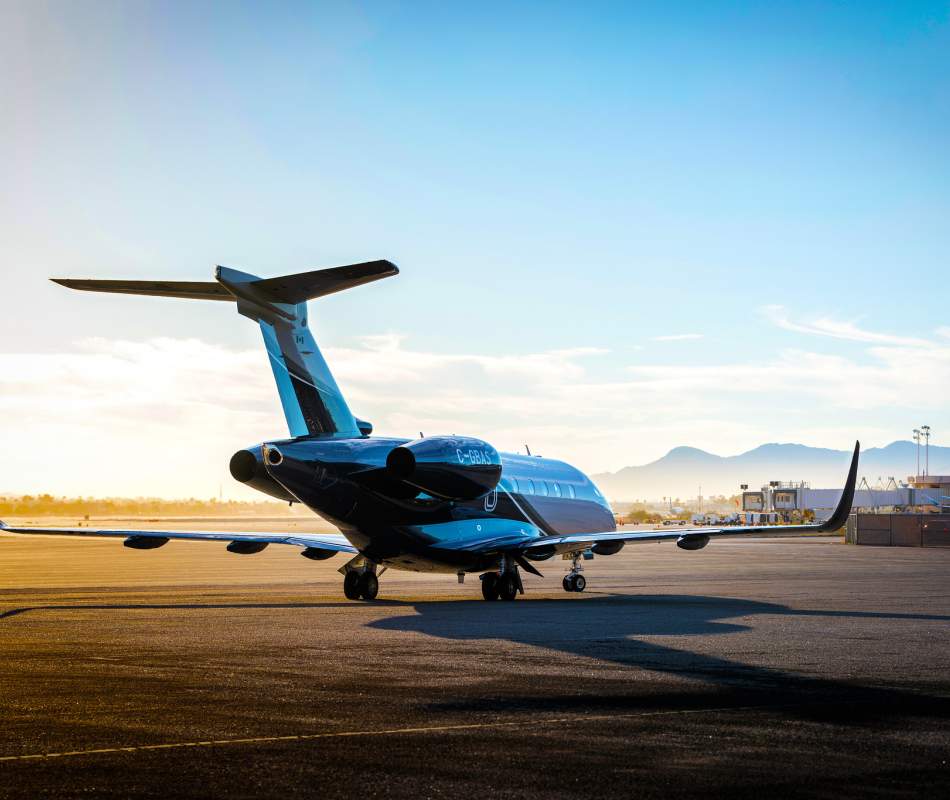
"All in all, an AirSprint pilot is likely one of the best pilots in Canada. They must be on top of their game considering all the new places they’re going."
Adam Fallwell, Director of Flight Operations, AirSprint Private Aviation
ASK AN AVIATION MANAGER
Meet Adam Fallwell
Director of Flight Operations at AirSprint Private Aviation
First, a bit of background. How long have you been with AirSprint, Adam?
Adam Fallwell: I’ve been here for almost 16 years now. I graduated from the Mount Royal College aviation program and spent several years as a flight instructor before joining AirSprint as a First Officer on the Pilatus PC-12. I’ve worked my way up through the company and today, as Director of Flight Operations, I lead the flight department. I am also a Captain on the Embraer Praetor 500/Legacy 450 jet.
Let’s take it back to basics. What are the minimum requirements to qualify for pilot training – age, medical, education, language?
AF: You must be a minimum of 16 years old to obtain your Recreational Pilot Permit (RPP), 17 years old to get your Private Pilot Licence (PPL), and 18 to get your Commercial Pilot Licence (CPL). Each step requires an aviation medical, with the CPL medical being more stringent. You must renew your medical once or twice a year, depending on your age and flying conditions. A high school education will be sufficient to begin your training. A basic understanding of math, geometry and algebra is important. You must also be fluent in English.
When someone is thinking of becoming a pilot, what training avenues are available?
AF: It starts with the PPL – you need to get that first. Many people go to the local flying school at a nearby airport. This is a good place to start to make sure you really want to do this – it’s not like driving a car, there’s a lot more to it. Then the next step is to pursue your CPL. Here, you can follow several paths: you can do self-paced training at the local flying school, attend a college or university aviation program where you earn pilot licences and ratings plus a diploma or degree, or enrol in an airline-sponsored cadet program. Of course, there is also the military for those who wish to serve. Keep in mind that your CPL allows you to work for money as a pilot, but that’s just the start. From there, you’ll get a Multi-Engine Rating and an Instrument Flight Rules (IFR) rating, which allows you to fly in bad weather. Those three together give you the tools for your first job.
Do you have any advice on choosing a flight school?
AF: Myself, I always recommend a college program. It’s very structured where you have to perform at certain levels or you are out. When I hire people, I do see a difference between college graduates and those who followed the regular (self-paced) path. I will hire both, but you do need more self discipline to do it yourself, outside of a structured program.
Aside from licences, what skills are critical for professional pilots, especially in a private aviation role?
AF: You must be able to provide excellent customer service – it’s huge in aviation! Personality-wise, we’re all kind of Type A “get it done” outgoing extroverts. You have to be a good communicator and a good listener. You must work well in a team, be able to assess your surroundings and make decisions on a changing basis, be confident in your decisions, and be humble enough to re-evaluate them. There is no room for egos in the cockpit.
What kind of jobs can a new pilot expect once they graduate?
AF: Historically, there’s been a couple of roads. One, get a flight instructor rating and teach people how to fly. That’s a great way to stay up on your knowledge and help train upcoming pilots. Two, you can apply for pipeline patrols, aerial surveying, medevacs or smaller turboprop operations, for example. The goal is to build your hours and experience. Right now, it’s a really good time to get into the industry – there are so many opportunities out there! Here at AirSprint, we are picky. We want the best of the best. We do prefer some prior experience. If we hire an inexperienced pilot, we know there is a big investment to be made. However, for the right person, we’re willing to make it.
Speaking of flying for AirSprint, where exactly do you operate?
AF: We are headquartered in Calgary and fly in North America, South America, Western Europe, Hawaii and the Caribbean.
How do your pilot schedules work?
AF: We have a rotational schedule based on a 13-month year with 28-day monthly blocks. Pilots must be available to work 16 days per month and then they have 12 days off. Our goal is that no one works more than half a year in total.
What does a day in the life of an AirSprint pilot look like?
AF: Every day will be a bit different. On your work days, you’ll generally find out what you’re doing the day before. You report for duty one hour before the flight departs, do your walkaround, flight planning and prep the aircraft. We will fly however many missions we have that day, and things can change rapidly. You may spend time waiting on the ground. Maybe you’ll do one leg, stay there for a few days, and go on after that. Or, something may come up so you have to leave immediately. It’s not like the airlines; here, every day is a new and exciting challenge. We go to thousands of airports; I still see new places after 16 years!
What are the policies surrounding pilots commuting in from out-of-town locations?
AF: We have several sub-bases outside of our main bases in Calgary, Montreal and Toronto. Pilots can live in places like Vancouver, Kelowna, Saskatoon, Winnipeg or Quebec City, and report for duty at their home airport. We try to give flexibility as much as possible. We have people across the country; often, this makes it easier to get someone to do a given flight.
How much can I expect to fly at AirSprint?
AF: On average, you can expect to log about 500 hours per year. Sometimes it’s more, sometimes it’s less, depending on the nature of the schedule.
What does AirSprint's pay scale look like?
AF: Check out our pay scale webpage where we’ve outlined typical Captain and First Officer (FO) salaries at AirSprint.
How does this pay compare to industry standard?
AF: I would say that AirSprint has a very competitive pay scale. Our FOs are some of the highest paid in Canada and our Captain salaries are very competitive. We offer excellent support structures, company culture and working conditions.
What does career progression look like at AirSprint?
AF: We are hiring new First Officers for the Cessna Citation CJ fleet with 1,000 to 1,500 hours experience, plus some turbine time. We do hire some instructors from flight schools. You can expect to learn the ropes as you go, with a lot of mentorship up to 2,500 to 3,000 hours flight time, when you are close to your CJ Captain upgrade. You’ll take your course, do a Captain check ride followed by a Captain line indoctrination, and then you will be released as a CJ Captain. We require everyone to become a Captain on the CJ first and then go on to the Embraer. It’s the natural flow to develop your Captain skills in the CJ. The Praetor and Legacy aircraft are doing overseas operations; they are bigger and more sophisticated. To become an Embraer Captain, it depends on where you start. If you come in with 3,000 hours you could be upgraded in six months. Otherwise, from day one as a new CJ First Officer, you’re looking at about three years to reach an upgrade point, two years as a CJ Captain, then on to the Praetor/Legacy Captain.
What does AirSprint's safety culture look like?
AF: Safety is our top priority. We have a very well structured Safety Management System that is part of our culture. Our pilots are fantastic about reporting issues – and every report we get is a chance to do better. We have our Standard Operating Procedures and a regulatory-compliant organization, with two maintenance departments in Calgary and Toronto. Maintenance is done properly, in-house, to our standards.
What makes AirSprint pilots different?
AF: All in all, an AirSprint pilot is likely one of the best pilots in Canada. They must be on top of their game considering all the new places they’re going. There is an important customer service aspect here, too. Our pilots are 20 per cent pilots and 80 per cent customer service experts to keep the clients happy. It’s a door-to-door service – we meet clients in the parking lot and their bags never touch the ground. Ultimately, you have to love to fly airplanes – that’s the most important thing. Some people think they will travel or make lots of money – but if you don’t love flying, then it won’t be the career for you.
Are there any other reasons to choose AirSprint?
AF: We operate the newest fractional fleet in North America, so you’ll experience the latest technology in aircraft systems – meaning situational awareness and the capabilities of our aircraft are second to none. Safety is inherent to our newer airplanes, featuring advanced fly-by-wire technology. They are pilots’ machines.
How do I apply?
AF: Interested applicants should apply through the Careers section of the AirSprint website. I encourage anyone who is interested to reach out to me or our chief pilots. If you’re keen on it, we can arrange to show you around the hangars in Calgary or Toronto, so you can see the airplanes.
Any tips on how to succeed in the pilot interview with AirSprint?
AF: Know the company – know our values and make sure it’s a fit for you. That’s really important. Also, make sure you are customer service-focused and enthusiastic about aviation. Be detail-oriented and prepared to work hard with your teammates.
Finally, why should pilots choose a career with AirSprint?
AF: AirSprint has always strived to be an alternative to the airlines. We emphasize work-life balance, with well-maintained and functional aircraft to get the job done safely and efficiently. AirSprint provides a fantastic opportunity to see places you’d never see working for an airline – including some of the busiest airports and some of the smallest. We’re growing quickly so there is lots of opportunity; in fact, AirSprint has outpaced international trends with a three-year growth rate of 96 per cent! We’re also a transparent operation – any one of the pilots can call any of us at any time if they have a concern. We’ve been around 23 years, and we always strive to improve every day.
AirSprint is now hiring! Apply today.

"AirSprint continues to exceed my expectations. Management is always open and happy to see you and everybody, including colleagues, supports each other. I’m in a very happy place and I get to meet and work with incredible people every day."
Mathieu Côté, First Officer CJ2+, AirSprint Private Aviation
ASK A LINE PILOT
Meet Mathieu Côté
First Officer on the Cessna Citation CJ2+ at AirSprint Private Aviation

Mathieu Côté, 23, started with AirSprint in the Fall of 2022, when he landed a job as a First Officer on the Citation CJ2+ business jet.
He began his flight training in April 2018 at Air Richelieu in St. Hubert, Québec. As he earned his Private Pilot Licence and then his Commercial Pilot Licence, Mathieu worked as a ramp attendant fuelling aircraft.
He’d always planned on an airline career, until a connection with the chief pilot of a Montréal-based charter operation led to a job rewriting the company’s Operations Manual and Standard Operating Procedures (SOPs). Suddenly, Mathieu discovered a whole new world: corporate aviation.
“I thought it was only for retired airline pilots who went on to do it later in life,” said Mathieu. “I have always been the person who likes the connection with the passengers. In the airlines, it’s just get in and off we go – pilots play a small role in personalizing the service experience with the passengers they fly.”
Here, Mathieu shares the story of how his private aviation career developed.
What attracted you to aviation, Mathieu?
Mathieu Côté: Ever since I was young, aviation was a passion for me. It stems from my father; he travelled a lot for his job. I also like the fact that once you park the plane you’re done for the day, besides the occasional training sessions you have to do to keep current. With this job, you don’t really bring work home.
What did you do when you finished your training?
MC: Right when I finished, Covid hit. During this period, the main choices were getting a job up north fuelling planes for a few months, or years, in the hopes of getting a flying job later. Or, going into flight instructing. I didn’t see myself in -40C temperatures up north, so I began instructing until September 2022.
What other unique experiences did you gather during this time?
MC: I was approached in 2020 by a consulting firm that trained me as an aviation consultant. I learned a lot about designing and renewing instrument approach procedures, and then about proposals for funding airlines, namely tackling logistical and supply chain issues. There was a lot of relevant industry learning. This is also the time when I discovered AirSprint. For me, a company’s culture and its values are very important. I feel like this is something that is often overshadowed by the general will to fly the biggest aircraft possible or to make the most money possible. The truth is that even though you might have one or both of these, if the culture and work ethic is bad, you probably won’t enjoy what you are doing. I really liked what AirSprint had to offer, both in terms of culture and working conditions. I sent my resume in and two weeks later, I had the job.
What do you like about the path you chose?
MC: Before Covid, I never thought I would end up being a flight instructor, but the pandemic happened and life guided me to that path. I learned a lot from instructing, especially on how to deal with different types of people. Also, the consulting industry is something I never thought I’d do. I cherish those experiences. The big takeaway here is you never know what’s going to come your way – so take advantage of opportunities and make the most out of it! Before Covid, I never envisioned being the person who would have taken chances and tried new things like these. One of the positive aspects of the pandemic is that it really pushed me out of my comfort zone on many levels.
Do you have any specific advice about choosing a flight school?
MC: Go visit multiple schools; don’t only rely on what they tell you on their website. Go in, get the vibe and inform yourself, not only from the enrolment department, but from students too. See what the program is like and what the maintenance is like; do the planes look well maintained, etc. The flight school I went to was dedicated to training airline pilots, and so was its program. Other schools might have different mentalities. There is also the question of choosing between part-time modular training versus a full-time integrated program. Ultimately, there are many options out there that offer different types of training, even though they all lead to the same Transport Canada-issued licences and ratings.
How do you compare programs with a degree/diploma versus doing all the licences at your own pace?
MC: I think it really depends on the era and your situation. If things in the industry are slow, the diploma/degree makes you stand out. However, if we are talking about the post-COVID era where companies are in a hiring frenzy, a diploma/degree is a bonus. I believe experience in the form of flight time and the types of operations you did, is the primary goal. I learned a lot from my prior work experience, too. An advantage with the aviation diploma following the completion of an integrated program is that it deepens the students’ knowledge, builds good knowledge bases and teaches discipline. It generally is significantly more expensive than a “regular” program to obtain your licences, which makes the modular option interesting in that sense.
When you think back to the time when you were making a decision to become a pilot, what questions did you have?
MC: Back when going to the airlines was my main goal, my questions were all about what path to take to get to work for them – it was a question easier asked than answered, because there are so many ways to get where you want to go. Before starting my flight training, I hadn’t realized how there were so many different sectors in aviation, such as medevac flights, companies that do seasonal flying in the Arctic, Antarctica and Africa, etc. When I discovered the world of private aviation, I realized that that this type of operation was tailored to what I was looking for as a career.
Besides flying skills, what other skills are necessary in your job at AirSprint?
MC: Discipline and adaptability are very important. You have a lot of training to do and you need to keep current on your procedures, systems and regulations. Teamwork is as important; you must be social and like working with people. I think of the same sentence my parents keep on telling me: “It’s all in the details.” When flying with our Owners, you must know your passengers’ needs and sometimes, interests, to personalize the service you offer.
Tell us about your work schedule – days on, days off.
MC: I am on the 18/10 standard schedule, so in a cycle of 28 days, I work 18 days and I have 10 days off. I like it, I really do. On average, I will have a positioning flight on the first day of my rotation and will be away from home for around eight days. Pilots on the standard schedule like me use the Preferential Bidding System (PBS) to bid on the days they want off (or on) by applying a weight, or score, to their particular requests. The system then does its best to give everyone as many of their requests as possible. We also have the option to request a rotational schedule, which, if granted, will give you your schedule with a set series of days on and off for the following six months. Pilots on the rotational schedule do not use the PBS.
What does your typical day look like?
MC: We generally get our trip sheets from the Integrated Operations Control Centre (IOCC) the day before we leave. They contain all the operational details related to our flights, as well as the Owner’s special requests, if any. After receiving the confirmations for our flights, we generally show up one hour before our departure time to complete our preflight checklists/procedures and prepare the cabin. A typical day on the CJ2+ will include three flights on average, totalling approximately three to four hours of flight time. We typically won’t stay for more than a day at our destination; however, we often have the time to relax and go for dinner in the evening. When we fly to our main hubs such as Toronto or Calgary, it isn’t rare for multiple flight crews in town to meet up and organize a get-together.
What is the coolest place you’ve flown since you started?
MC: Every place is different. I’m not going to shock anybody by saying that going to sunny destinations in the winter time is great! A first cool destination that comes to mind is New York, with its busy airspaces and scenic sights. For sure, it’s interesting, but with the wide variety of destinations that AirSprint goes to, you get to see places like Cheyenne, WY, or Hailey, ID, that each have their own charm to discover, a charm that you wouldn’t otherwise think to explore when planning a vacation.
Looking back at your career so far, is there anything you would do differently?
MC: No. I am a firm believer that what you did in the past leads you to where you are today. I’m pretty happy with where I am today, I’ll tell you that! The culture aspect of AirSprint goes beyond the values page on the website; we’re a big family. I’m hearing from some of my pilot friends that the companies they work for portray themselves as one thing and the reality is disappointingly different. AirSprint, on the other hand, continues to exceed my expectations. Management is always open and happy to see you and everybody, including colleagues, supports each other. I’m in a very happy place and I get to meet and work with incredible people every day.
We are committed to our employees.
© 2023 AirSprint Inc. All rights reserved. This paper was produced for AirSprint by Mustang Media Writing & Editorial Services
